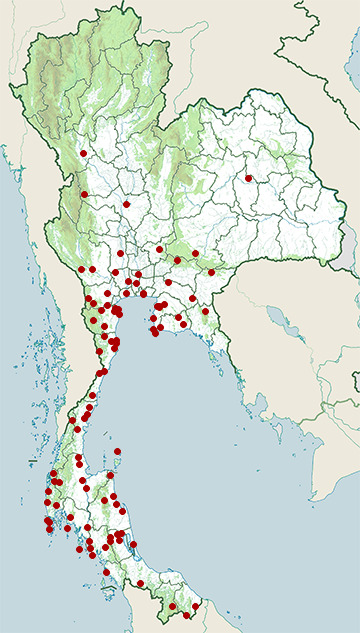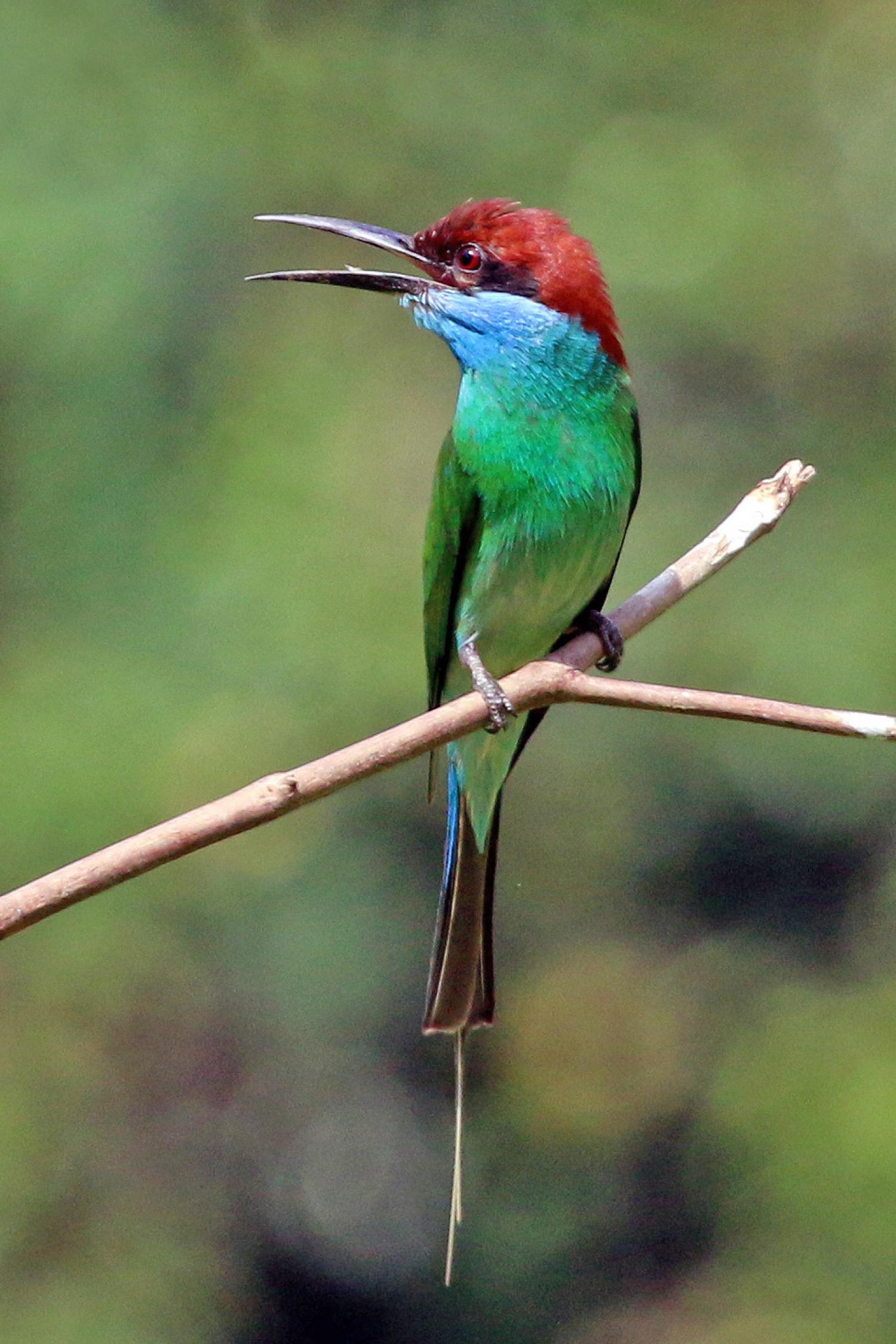Species of Thailand
Blue-throated bee-eater
Merops viridis
Carolus Linnaeus, 1758
In Thai: นกจาบคาคอสีฟ้า
The Blue-throated bee-eater (Merops viridis) is a species of bird in the bee-eater family. They are found throughout southeast Asia in subtropical or tropical mangrove forests. Their diet consists mostly of bees, wasps, and dragonflies. Blue-throated bee-eaters are small with colorful plumage consisting of a red nape, dark green wings, light green breast, and their signature blue throat. Juvenile plumage contain dark green head and wings and light green breasts, only developing their full plumage in adulthood. They have a rich variety of songs and calls, including longcalls which allow them to communicate long distances in the forest.
Blue-throated bee-eaters practice asynchronous brooding, which means that chicks hatch at different times, often pairing with siblicide. Older chicks are not only larger and able to withstand larger wounds from other siblings, but also have the ability to monopolize the food they are fed by parents. There has been several observations of migration between islands in southeast Asia or onto mainland of Asia. One notable seasonal spring migration occurs from Sumatra, across the Strait of Malacca, and ending on the west coast of Malaysia. They also migrate from southeast Asia to breeding grounds in western China during breeding season.
Conservation status of the blue-throated bee-eaters is of "least concern" due to their large distribution and stability of its population as of 2016. However, deforestation may be its biggest threat, destroying its habitat and decreasing other bird diversities.
Taxonomy and systematics
Blue-throated bee-eaters are part of the family Meropidae, which are the bee-eaters, including 27 other birds. Another alternate common name they have is the chestnut-headed bee-eater.
Subspecies
Two subspecies are recognized:
- M. v. viridis - Linnaeus, 1758: Found from southern China to Indochina and the Greater Sundas
- Rufous-crowned bee-eater (M. v. americanus) - Statius Müller, PL, 1776: Considered by some authorities as a separate species. Found in the Philippines
M. v. americanus was previously identified to be the same as M. v. viridis by Sibley and Monroe in 1990 and 1993. They have only recently been separated into subspecies.
Description
Adult blue-throated bee-eaters grow to around 21 cm, with an additional 9 cm including tail streamers. They weigh around 34 to 41 grams. Adults have spectacular plumage with a red crown and nape, dark green wings, blue tail, light green breast, white belly, and the signature blue throat. Juveniles develop their full plumage later, with mostly green coloration all over their body. They have a dark green head and wings and light green breast. Both adults and juveniles have black eye patches. Eye color can range between red and brown, or a combination.
Vocalizations
Blue-throated bee-eaters make a combination of vocalizations characterized as longcalls, alarm calls, chirps, low chirps, purrs, sharp coos, trills, and feeding calls. Longcalls have been observed to communicate long distances and are recognizable by their volume and intensity. A longcall is performed either during flight or on a perch by stretching and pointing their bill upwards, known as a “longcall” posture. Chirps are short and sharp with regular intervals, often used during digs.
Distribution and habitat
They have a wide distribution ranging from southeastern China to the Greater Sundas Islands. The most concentrated distribution is found in Singapore, Malaysia, southern Cambodia, and southern Thailand. Other locations with greater dispersal include Borneo and Java. They live in lower elevations between 0–670 meters. Their habitat includes a wide variety of flat plains, such as farmland, suburban gardens, riversides, dunes, and sandy clearings. In the winter, some blue-throated bee-eaters move to forest canopies and saltwater channels of mangrove forests. They often dig burrows horizontally into flat ground, allowing easier access compared to burrows in sand cliffs of other bee-eaters. Colony sizes range from 50 to 200 pairs or living completely solitary in the open country.
Breeding
Blue-throated bee-eaters have a generation rate of around 6.2 years. They practice asynchronous brooding, meaning parents begin brooding at different times. This results in hatching of chicks at different times. The eggs hatch over a period of ten days with an average spread of 4.43 ±12.15 days. The sequence and timing of the hatching of chicks is correlated with size, with the first-born chick having the greatest mass. Parents lay two to seven eggs with a survival of zero to three chicks raised to fledging. The chicks normally die in order, starting from youngest and smallest. The observed death rate in chicks was largely caused by sibling attacks by utilizing a sharp hook on the upper bill, later lost in development, and inflicting wounds on the naked head of other chicks. Those chicks who are older have time to grow more contour feathers, protecting them from damaging attacks. Siblicide is common among other birds to increase the larger and older chick's survival with greater access to food by the parents. Sibling attacks are more common among birds when food is scarce and monopolized. In the blue-throated bee-eater's case, insects are delivered one by one to the chicks, making food easily monopolized to chicks with the greater advantage. Increasing brood size did not increase the survival of the chicks. Decreasing body mass is correlated with increasing wounds and scars found on the individual chicks, which increased the likelihood of death.
Food and feeding
They predominantly feed on flying insects such as bees and wasps. Other insects caught include flies, beetles, and other bugs up to 42mm. A large percentage of the blue-throated bee eater's diet consists of dragonflies with highest success rate of their catches in sunny conditions. Observations found no feeding activities during rain and right after showers. Their feeding patterns are well-matched with the seasonal weather patterns. The highest feeding rate is during breeding season, perfectly matching the sunniest period, right after the rainy season.
Migration
Each spring, blue-throated bee-eaters (Merops viridis) along with blue-tailed bee-eaters (Merops philippinus) migrate from Sumatra, cross the Straits of Malacca, and end up on the west coast of Malaysia. The observed flight locomotion from Tanjung Tuan, west coast of Malaysia, was a combination of flapping and gliding flight. Occasionally, they would use the air currents from the sea-breeze to soar upwards. Once reaching land, they would rest on the lighthouse and tree branches for up to ten minutes before continuing eastward. This migration was observed from 2000 to 2001 with a total of 2, 226 bee-eaters, with 1353 blue-tailed bee-eaters, 222 blue-throated bee-eaters, and the rest unidentified. The most observed migrating bee-eaters occurred on 21 March 2000 between 1-2PM. The high number observations of bee-eaters were most likely due to the strong thermals that formed over Sumatra, allowing them to soar over the sea-breeze with ease. High numbers of bee-eaters were also observed to migrate when there were high westerly winds blowing towards Malaysia. Blue-throated bee-eaters also migrate onto breeding grounds of western China during breeding season as shown in the range map above.
Relationship to humans
Humans act as a threat to blue-throated bee-eater habitats. They have been characterized as "least concern" in terms of conservational status, which is determined by a combination of range distribution, population stability, habitat loss, and potential threats. This was last assessed on October 1, 2016. humans have impacted avian richness in the hill dipterocarp tropical rainforests in Malaysia. Logging and destruction of rainforests can impact not only individual bird species, but also the diversity of birds in the region. Diversity of species can bounce back within thirty years post-logging and was observed to have higher species richness in terms of bird diversity and numbers compared to recently logged forests.
Although uncommon, they are sometimes kept as pets and used for horticulture.
This article uses material from Wikipedia released under the Creative Commons Attribution-Share-Alike Licence 3.0. Eventual photos shown in this page may or may not be from Wikipedia, please see the license details for photos in photo by-lines.
Category / Seasonal Status
Wiki listed status (concerning Thai population): Resident, winter visitor and passage migrant
BCST Category: Recorded in an apparently wild state within the last 50 years
BCST Seasonal statuses:
- Resident or presumed resident
- Non-breeding visitor
Scientific classification
- Kingdom
- Animalia
- Phylum
- Chordata
- Class
- Aves
- Order
- Coraciiformes
- Family
- Meropidae
- Genus
- Merops
- Species
- Merops viridis
Common names
- Thai: นกจาบคาคอสีฟ้า
Conservation status

Least Concern (IUCN3.1)
Photos
Please help us review the bird photos if wrong ones are used. We can be reached via our contact us page.
Range Map

- Ban Bueng District, Chonburi
- Ban Chang District, Rayong
- Ban Laem District, Phetchaburi
- Bang Lamung District, Chonburi
- Bang Lang National Park
- Bang Phra Non-Hunting Area
- Bang Pu Recreation Centre
- Bang Saphan Noi District, Prachuap Khiri Khan
- Bangkok Province
- Bueng Boraped Non-Hunting Area
- Chaiya District, Surat Thani
- Hala-Bala Wildlife Sanctuary
- Hat Chao Mai National Park
- Hat Wanakon National Park
- Hua Hin District, Prachuap Khiri Khan
- Huai Yang Waterfall National Park
- Kaeng Khoi District, Saraburi
- Kaeng Krachan National Park
- Kaeng Som Maew Queen Sirikit Forest Park
- Kamphaeng Saen District, Nakhon Pathom
- Kantharawichai District, Maha Sarakham
- Khanom District, Nakhon Si Thammarat
- Khao Ang Rue Nai Wildlife Sanctuary
- Khao Banthat Wildlife Sanctuary
- Khao Dinsor (Chumphon Raptor Center)
- Khao Khiao - Khao Chomphu Wildlife Sanctuary
- Khao Luang National Park
- Khao Nam Khang National Park
- Khao Phra - Bang Khram Wildlife Sanctuary
- Khao Pu - Khao Ya National Park
- Khao Sam Roi Yot National Park
- Khao Soi Dao Wildlife Sanctuary
- Khao Sok National Park
- Khao Yai National Park
- Khao Yoi District, Phetchaburi
- Khuan Khanun District, Phatthalung
- Khura Buri District, Phang Nga
- Klaeng District, Rayong
- Ko Lanta National Park
- Ko Libong
- Kui Buri National Park
- Laem Pak Bia
- Mae Wong National Park
- Mu Ko Phetra National Park
- Mueang Kanchanaburi District, Kanchanaburi
- Mueang Krabi District, Krabi
- Mueang Nakhon Si Thammarat District, Nakhon Si Thammarat
- Mueang Pathum Thani District, Pathum Thani
- Mueang Phang Nga District, Phang Nga
- Mueang Phatthalung District, Phatthalung
- Mueang Phetchaburi District, Phetchaburi
- Mueang Phuket District, Phuket
- Mueang Ratchaburi District, Ratchaburi
- Mueang Samut Sakhon District, Samut Sakhon
- Mueang Suphanburi District, Suphan Buri
- Mueang Tak District, Tak
- Nong Thung Thong Non-Hunting Area
- Nong Ya Plong District, Phetchaburi
- Nong Yai Area Development Project Under Royal Init
- Pachee River Wildlife Sanctuary
- Pak Phanang District, Nakhon Si Thammarat
- Pak Thale
- Pang Sida National Park
- Pathio District, Chumphon
- Phi Phi Islands
- Phunphin District, Surat Thani
- Phutthamonthon District, Nakhon Pathom
- Pran Buri District, Prachuap Khiri Khan
- Pran Buri Forest Park
- Ratchasan District, Chachoengsao
- Sai Yok District, Kanchanaburi
- Sakaerat Environmental Research Station
- Samae San Island
- Samut Prakan Province
- Sathing Phra District, Songkhla
- Sattahip District, Chonburi
- Sawi District, Chumphon
- Si Racha District, Chonburi
- Sikao District, Trang
- Sirinat National Park
- Sri Phang Nga National Park
- Su-ngai Kolok District, Narathiwat
- Takua Pa District, Phang Nga
- Tha Chana District, Surat Thani
- Tha Sala District, Nakhon Si Thammarat
- Tha Yang District, Phetchaburi
- Thai Mueang District, Phang Nga
- Thalang District, Phuket
- Thale Noi Non-Hunting Area
- Than Sadet - Koh Pha-Ngan National Park
- Thao Kosa Forest Park
- Wang Chan District, Rayong
- Wang Mai Forest Restoration Project
- Yan Ta Khao District, Trang
